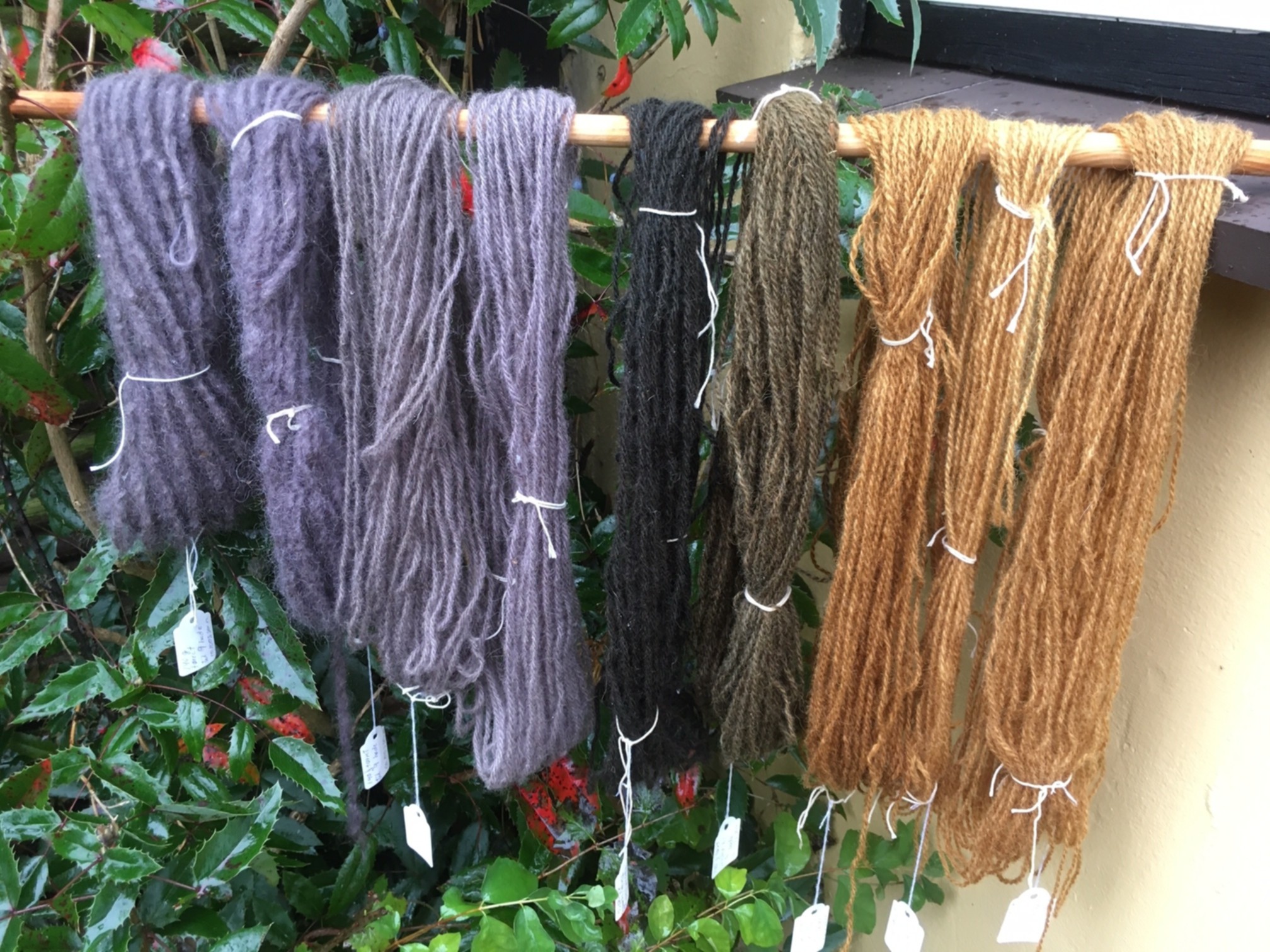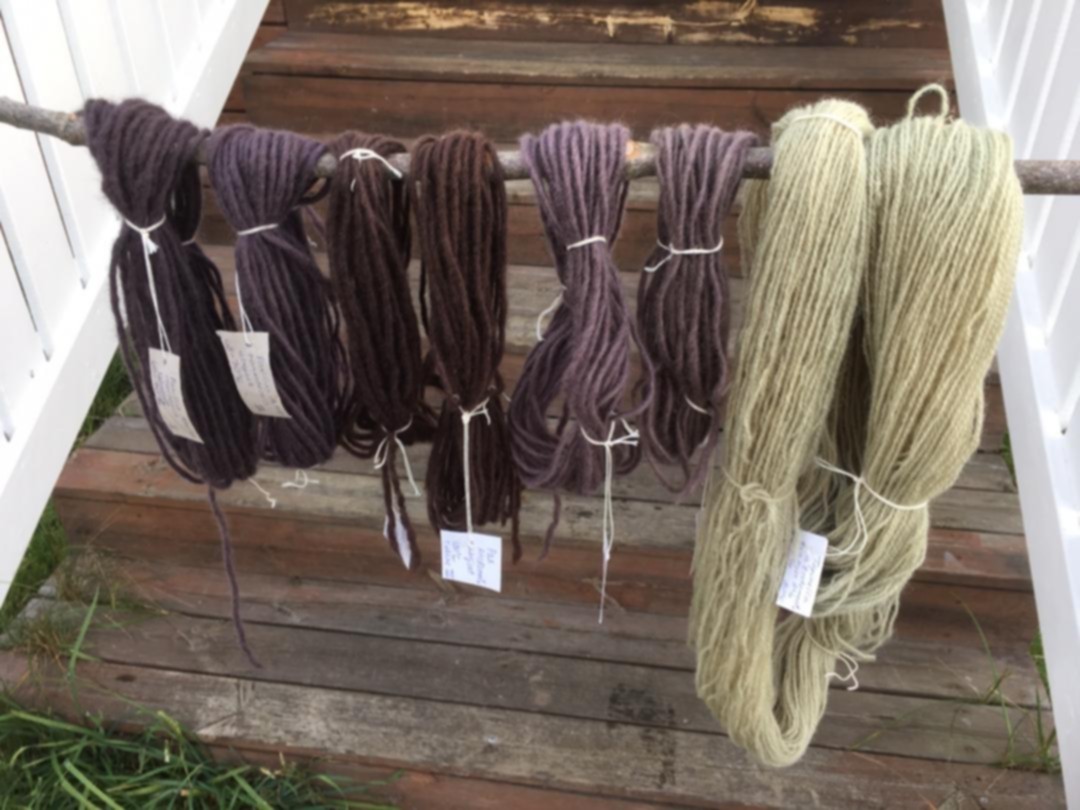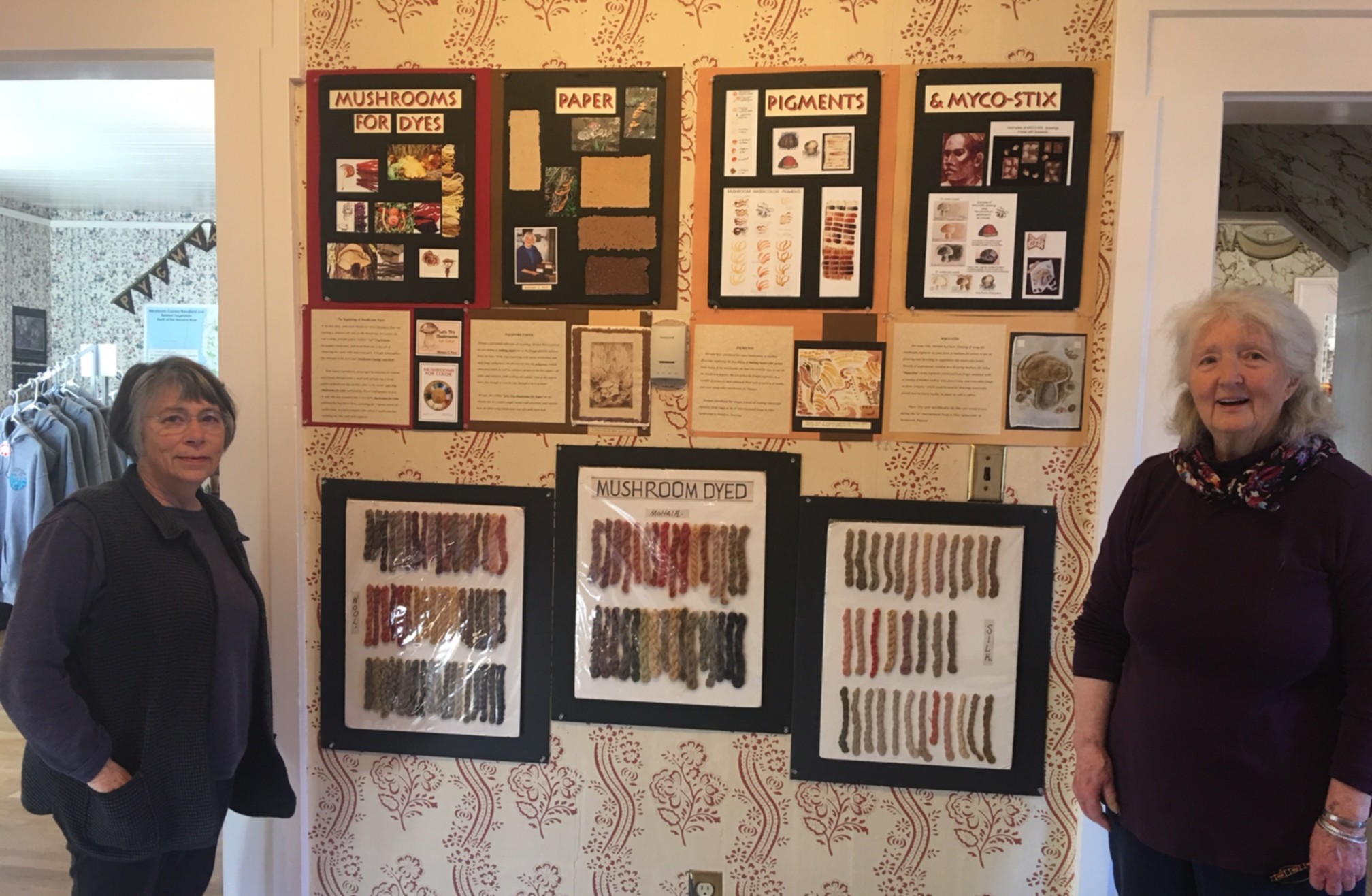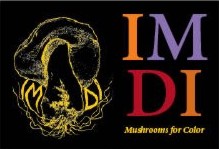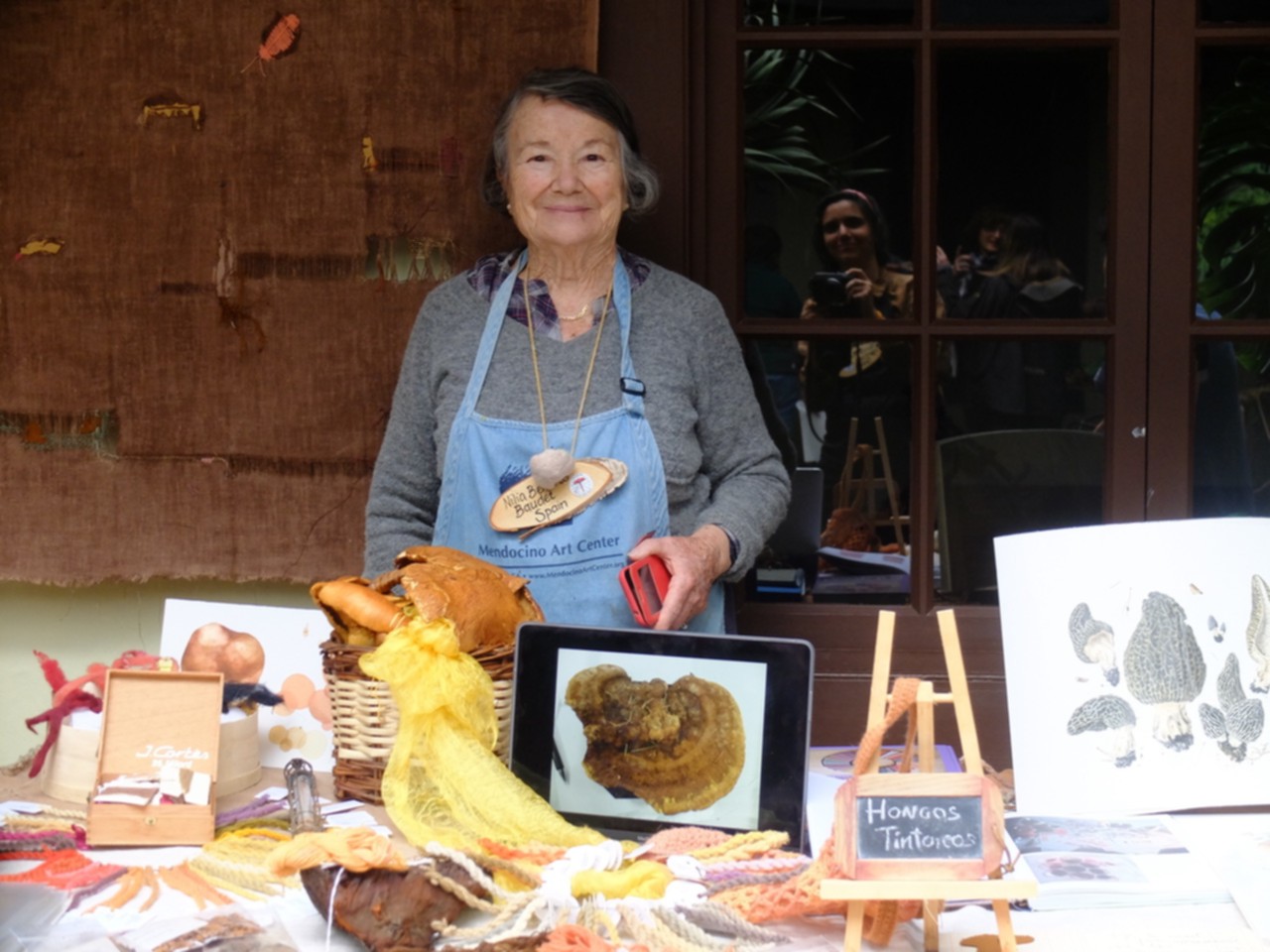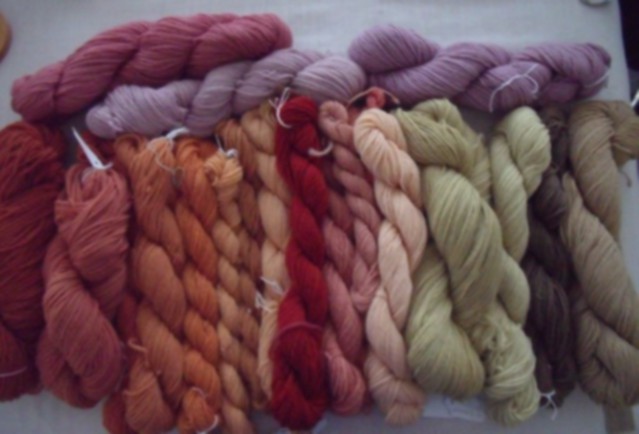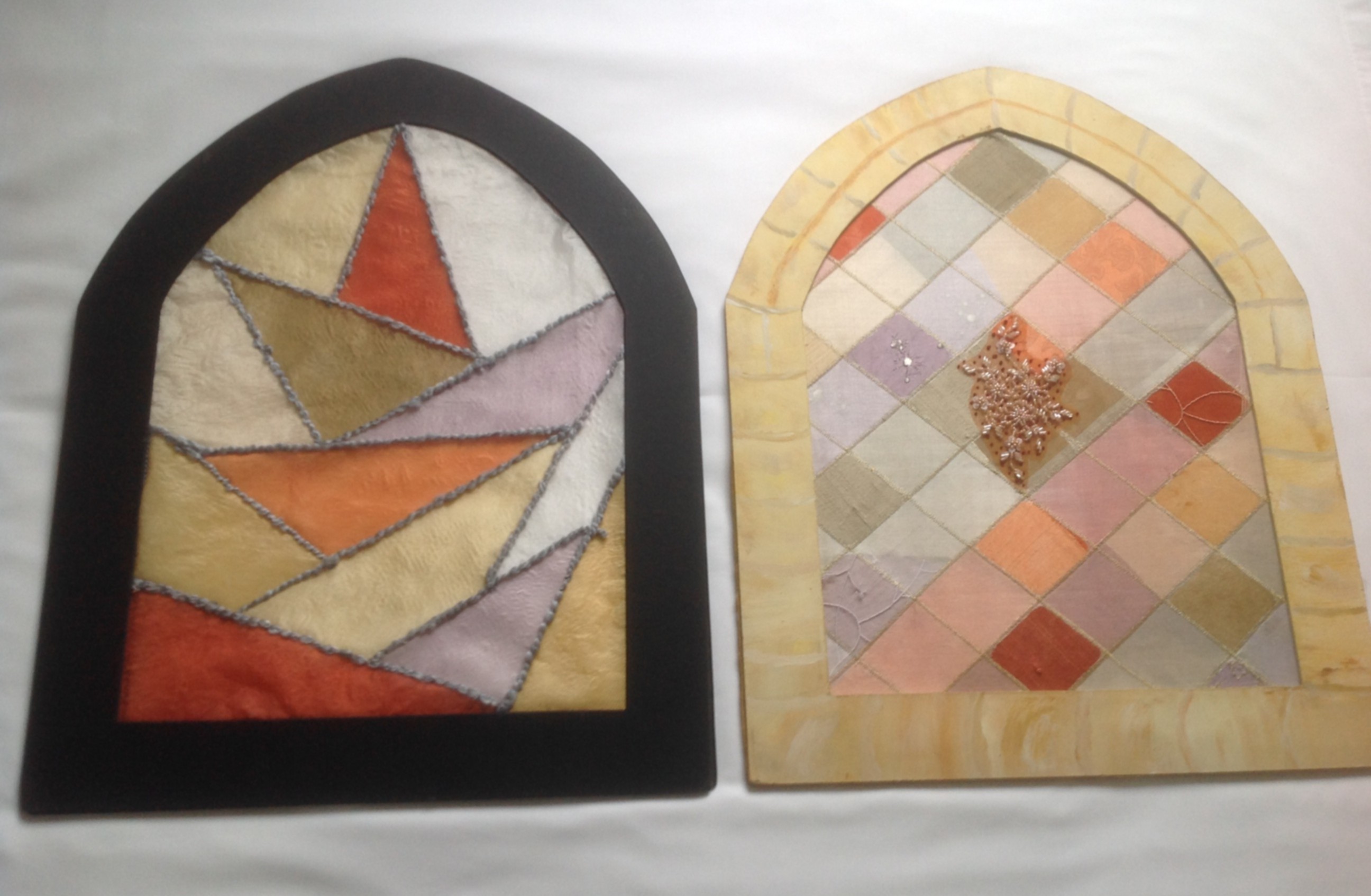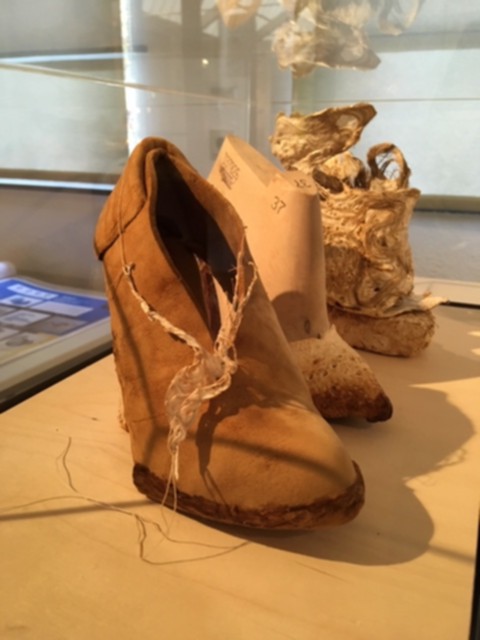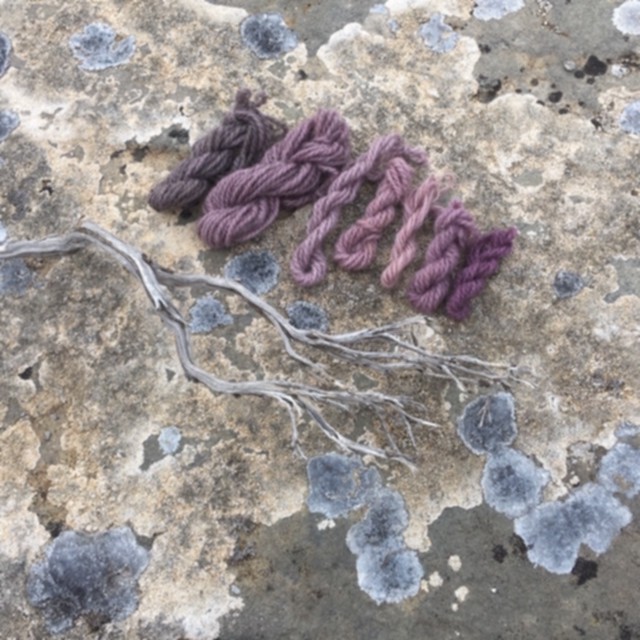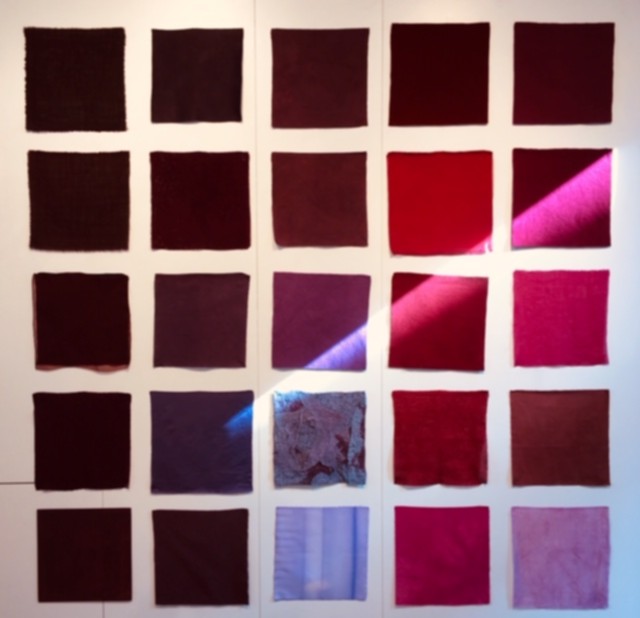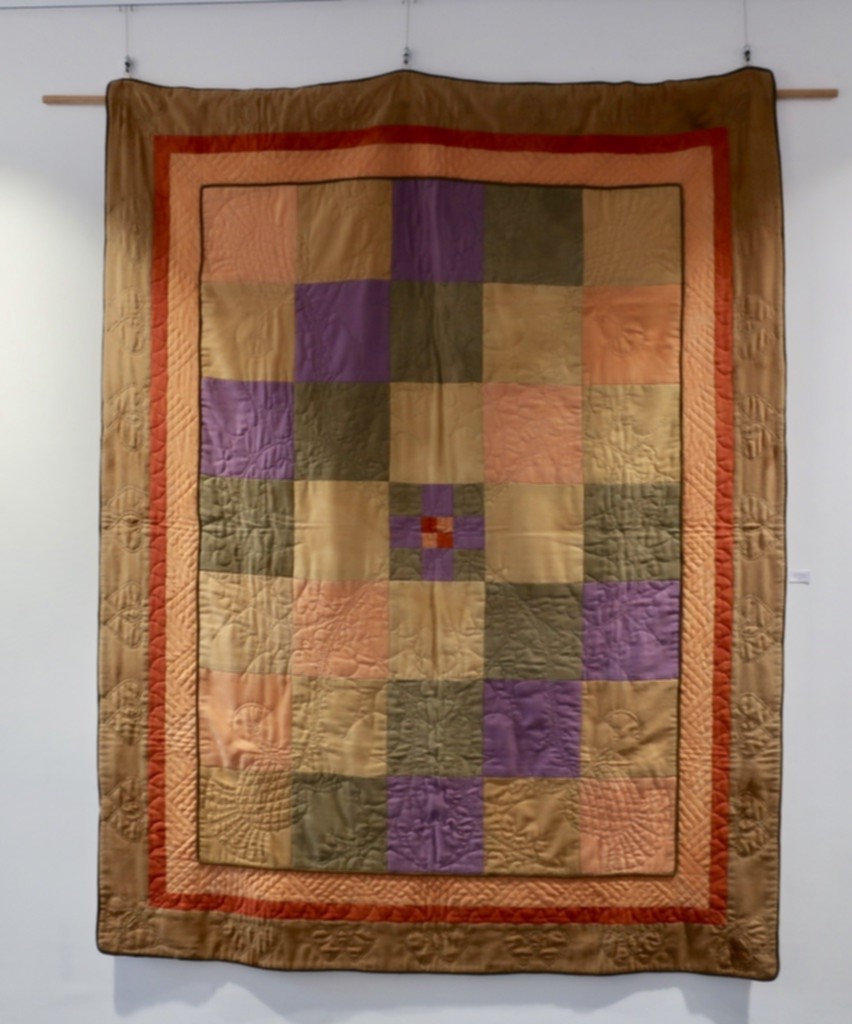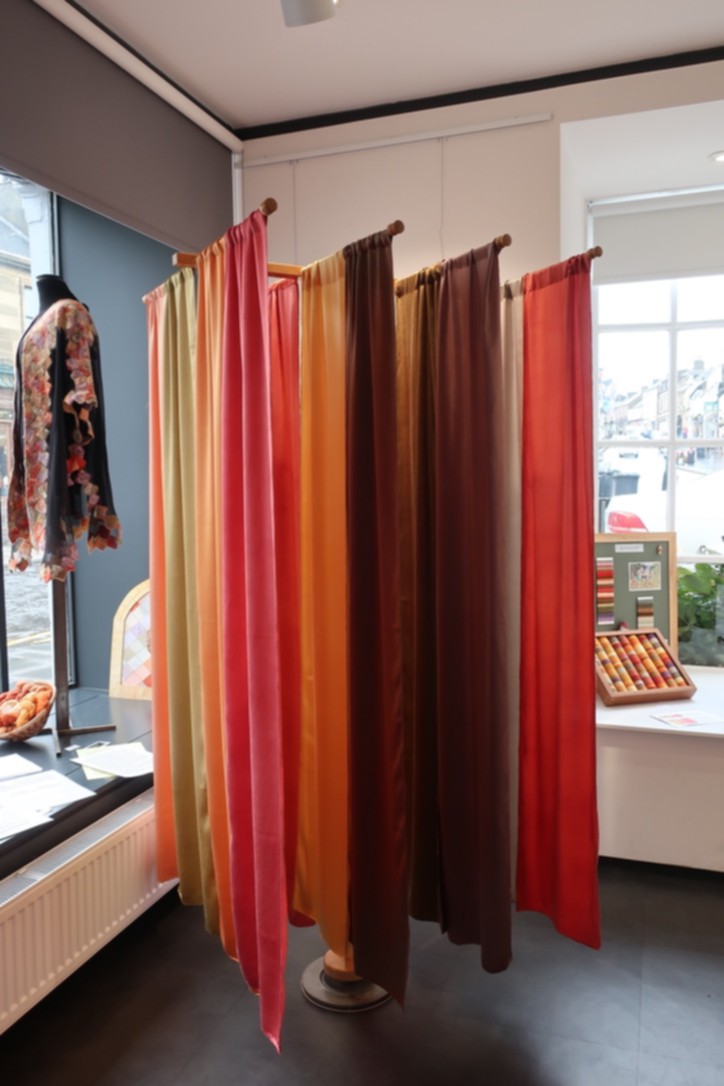| At
the 14th IFFF Symposium in Sweden in 2010 it was decided to begin an IFFF
Yearly Newsletter to keep us all in communicdation
between Symposia. Representatives from each participating country would
submit articles about the fungal fiber arts in their country, and
it would be published here, on the IMDI Website, in
PDF form, for
easy printing, and also as individual pages with graphics for easy
reading online.
|
International
Fungi & Fibre Newsletter 2019
In this newsletter we have
contributions and images from Belgium, Canada, Denmark, England, Scotland,
Spain, Sweden and the USA. I hope you enjoy reading about our fungi
fun and exploration. My thanks to Dorothy Beebee for putting this on
the mushrooms for color website.
With best wishes,
Trisha Gow, Newsletter Co-ordinator |
SWEDEN ~ Liza Johansson
This year I have taught about eatable mushrooms and I also talk about
fungi for dye at a folk high school in Sweden. There was a group
of young girls who became very interested in pigment from mushrooms
when I showed that you can dye yarn and paint with the pigments.
These girls would start a group and want to dye together and they
started immediately the same day! They had never before heard of
using mushrooms in this way! I have also had a mushroom exhibition
in another place of Sweden where I have shown eatable mushrooms,
poison mushrooms but also what fungi you can dye with and use for
pigment for painting. Many became interested and had many questions
about this. The interest is great when you start talking about it.
In recent years, I myself have become interested in counting in wood.
My next challenge is to use fungal pigments on wood. This is certainly
interesting for many craftsmen.
I have been experimenting with some and hopefully I can share this during
the symposium. Now I´ve started to translate my book ”Pigment and Paper
from Fungi” to English and hope to have it for the next symposium 2020! best wishes, Liza |
SPAIN, Gran
Canaria, the Spanish Contingent
Last year’s mushroom season in Gran Canaria was especially
abundant in
Gymnopilus penetrans and G. spectabilis as well as the
always generous Pisolitus tinctoreus. We put up a demonstration
on Fungi dye during the local mycological fair held by the Sociedad
Micológica de Gran Canaria where we showed off what we learned
and did in Norway. We are still working on the book on Nilia Bañares’s
experience dyeing with mushrooms that will hopefully be finished
by next year. We would like to make a call out to any natural dyers
in Spain working with fungi. Our email is tintesconhongosES@gmail.com.
|
Photo of Nilia Bañares by Palma Christian. |
DENMARK ~ Jytte
Albertson |
Tapinella atrotomentosus dyeing
with dried mushrooms
I had 140 g dried mushrooms in the dyepot.
From left : dyebath 1-2-3-4 No mordant. Temperature 62-63 degrees C.
From left : dyebath 5-6-7-8 Tin mordant.
Dyebath 9 tin mordant with a little iron added( gave a little darker colour
than dyebath 9) |
I think it is nice with the purples,
but I have not done any lightfastness tests yet. And it takes a lot of
mushrooms. All dyed with fresh Tapinella atrotomentosus.
From left : 1 and 2 no mordant 65C 50 min. 3 and 4 no mordant 95C.
I had the temperature at 65C for 35 minutes and the yarn had a really dark purple.
Left it for coffee and when I returned the dyebath was boiling, and the yarn
had turned dark brown ( ! hm )
|
The last skein yarn ( tin mordant )
got a nice pale green colour.
This was my first try with tapinella on yarn without mordant. Has anyone
succeeded to achieve purple with dried tapinellas?
Greetings, Jytte |
CANADA ~ Ann Harmer
We were blessed with a wonderfully rainy mushroom season for the 2016
Symposium on British Columbia’s West Coast, but the next two summers
were so dry and the autumn rains so late that the dye mushrooms were
hard to find and few in quantity. Fortunately, this year we’re back
to our typical rainforest conditions, and the fungi are popping out
everywhere.
We have a presence in the Sunshine Coast Fibreshed, a group that
encourages sustainable fashion, particularly throught the use of
local fibres and natural dyes. We plan a workshop for interested
members of that group some time in the new year.
Ann Harmer had put just enough fungi aside to give one workshop in
the
spring of 2019 for a fibre arts guild on Vancouver Island, so perhaps
we can expect some new converts at IFFS 2020. Undaunted, Muriel Prior
has used the mushrooms she purchased at IFFS 2018 in Norway to dye
enough fibre for another colourful sweater, which we can expect to
see next year in Port Townsend! (Photo by Muriel Prior)
|
USA ~ Alissa Allen
Bountiful Fall Harvest in the Pacific Northwest The Pacific Northwest
has had an incredible year for dye mushrooms. After a cool
summer with plentiful rain followed by a damp but not overly saturated
fall, we have seen more of the blue-green dyers (Thelephorales)
than ever.
Hydnellum regium, Hydnellum peckii, Hydnellum
aurantiacum group,
Polyozellus spp, Boletopsis spp and Sarcodon spp have been
fruiting in
abundance. One group of folks in Washington reported harvesting
70lbs (30k) of Sarcodon spp in one day!! Phaeolus
schweinitzii, Tapinella atrotomentosa,
and Hypomyces lactifluorum have also been reported in
massive quantities. I has yet to be seen if the dye Cortinarius will
make such an appearance, but are ever hopeful.
We are encouraging people to stockpile dye mushrooms to offer at
the
upcoming International Fungi and Fibre Symposium. In years past,
dye mushrooms have been for sale in the boutique on a first come,
first served basis, which can be disappointing to folks at the back
of the line. At the 2020 IFFS we plan to offer dye mushrooms in a
silent auction. The asking minimum price will be paid to the seller,
but the balance of any higher bids will go directly to the IFFS “seed
fund” to cover the upfront costs for the next event. You can read
more about the
2020 IFFS at http://mycopigments.com/2020iffs/ Please
be sure to sign up for announcements by clicking “contact us” at
the bottom of the page. Happy holidays and happy hunting to those
whose mushroom season is just getting started!
Alissa Allen
|
ENGLAND ~ Carole Thorpe
Irene and I gave a talk to the Cambridge Guild on Fungi Dyeing early
in the
year, which was enjoyed by all. A great many question and interest
shown. I wish to mention Irene Taylder, who died in February, she
was a very close friend and, I think I am right in saying, she
has attended every symposium since 1993 in Scotland. Not only
will she be missed by a great many fungi friends, she was a true
a loyal friend to me and I miss her so much.
Carole
Dyed silk stained glass windows by
Carol Thorpe and Irene Taylder
|
BELGIUM ~ Marina Lamsens,
Flanders, Belgium
‘Mushrooms everywhere!’
An abundance never seen before . We wander through the woods with
a camera “to catch” the autumn fruit bodies of the hidden mycelia
. We do not have baskets with us to collect specimens because...
It is forbidden to pick them: nature protection rules So we continue
our mushroomdye-experiments for small projects with the material
we brought from Norway or abroad.
Foto by Marina Lamsens: Hapalopilus - happiness - Pyrenees, 2019,
samples
Marina Lamsens
Last year 2018 we were very
lucky to visit a wonderful travelling exposition “ fungal futures
3”, in Ghent, Belgium. Mycelium art-mycelium science-mycelium
steam mycelium architecture and building. (the Netherlands) Science,
art and design working together! There were workshops and a competition.
We thought of Ninela Ivanovas designs People were invited to
work in an innovative way with mycelium: www.fungalfutures.com
www.glimps.bio/bootcamp www.dewereldvankina.be, Officina
corpuscoli, e.a
Foto by Marina Lamsens: Kristel
Peters shoes - Fungal futures, 2018
www.shoedesigner.be |
In Brussels,
“Nuances de plantes “ organized a congres: ”Du pourpre à la
pourpre”. Two days of purple workshops, conferences and exhibition. Annie,
Maggy and me contributed with purple dyed (also lichen) fabrics in the collective
artwork.
|
Foto by Marina Lamsens: Color
purple collective work, 2018
Fotos
by Marina Lamsens: Samples of Maria Boto ordonez, 2018 |
Maria Boto Ordonez showed us in the congres the exciting
experiments with bacteria that create color! She does research in the
Experimental Biolab for Art and Design KASK School of Arts Belgium,
Ghent.
|
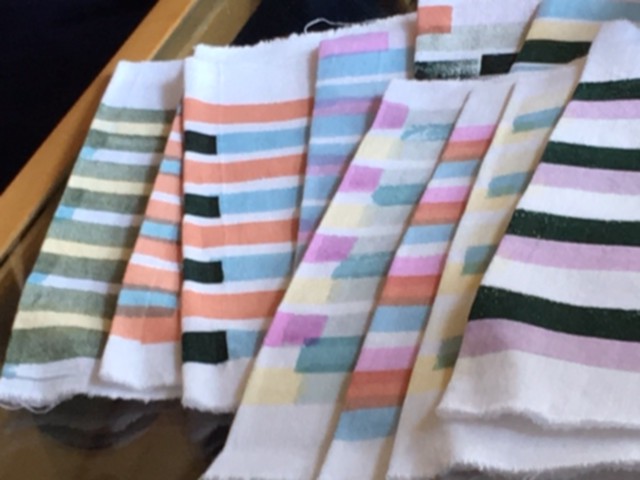
|
So, living in this small country,
we hear young people talking about
mushrooms, alternative dye processes and mycelium ! Almost whispering and spreading
the mysterious mushroom knowledge, we dream about healthy forests, plenty of
mushrooms and we are waiting for the “benediction” to harvest them !!
Kind regards from Flanders, Belgium,
Marina Lamsens |
SCOTLAND ~ Marilyn Caddell
Greetings from Scotland. It is hard to believe that it is 26 years
since we
hosted the 6th IFFF symposium here in Edinburgh in 1993. Back
then the Scottish Fungi Group had a good number of members, which
has sadly diminished. We really miss Jeanette McKeown, and also
Irene Taylder who died earlier this year. On the plus side we
have welcomed Veronica Collins. Over the years, sometimes together
with Irene and Carole Thorpe from England, we have made group
exhibits to take to the various IFFF Symposia. Recently the Tolbooth
building in Lanark, the town where I live, was renovated and
made into a community hub and exhibition gallery. I suggested
that it would be great to put on an exhibition of our work for
the general public to see the fantastic colours that some fungi
contain – if we can find the right ones!
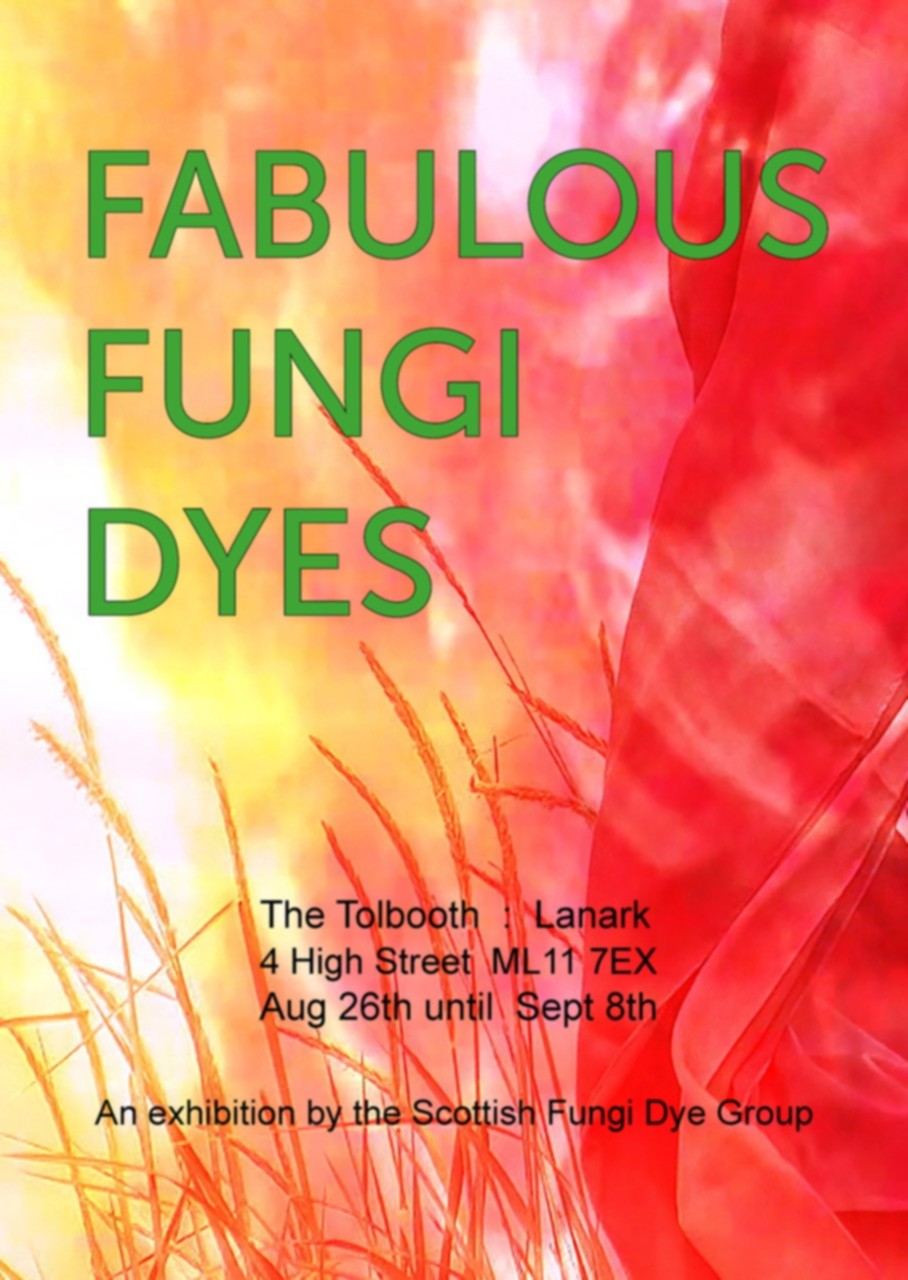 |
This we did from August 25th
to 9th September, calling the exhibition “Fabulous Fungi Dyes”.
Four of us set it up – Trisha Gow, Su Grierson, Veronica and
myself. As well as group exhibits and some of our own work we
received items made by Fiona Moir, Irene Taylder, Carole Thorpe
and Anna King. Plus posters from Liza Johansson in Sweden showing
her use of fungi dyes for making paints and Ninela Ivanova from
Bulgaria (now living in England) showing her fungi dye use in
her fashion design. |
Our first group exhibit was
a 7 foot felted Magic Mushroom to take to the 1995 symposium
in Sweden. We joined the Scottish Felters and spent a fun weekend
creating it. The basic mushroom shape, white with a red cap,
was covered with a myriad of small fungi shapes and was a kaleidoscope
of colour. |
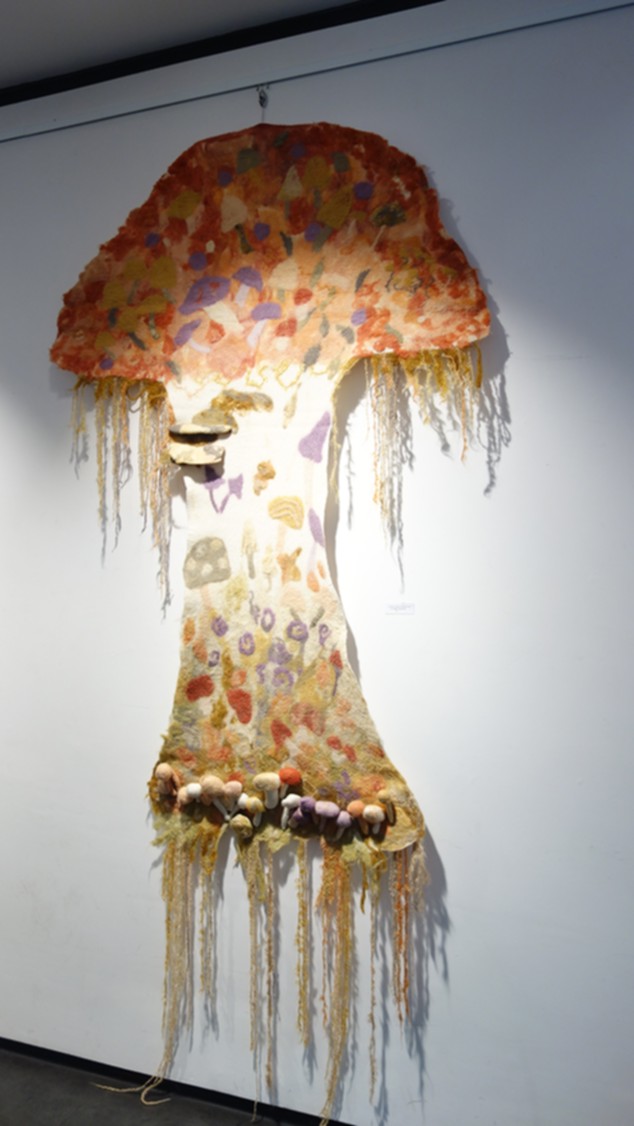
Then for the 1997 symposium
at Lake Saranac in USA we decided to make The Fungi Quilt.
Seven of us took over 400 hours to make it! The central panel
is made up of 9” wool squares dyed green, yellow, gold, orange
and purple, with the stitching representing Scottish thistles
and the traditional Luckenbooth motif. The centre square has
our initials, the date and Hale Bop – the comet that went across
the sky that year. |
At the 2001 symposium in Finland
we dyed 15 silk scarves . The aim was toget as strong a colour
as possible from the dye baths.
They hung from the ceiling on
two wooden frames and looked stunning, the shimmering silk
highlighting the beautiful colours. |
Some years we made individual items with a common theme
e.g. using only
one mushroom to obtain all the colours; each having four 4” blocks
of wood to cover the surface in fabric/felt as a set; and making sporrans
to take to Australia in 2003, wearing them to the dinner on the last
night.
Other individual exhibits included the following Trisha Gow - beautiful
tapestry woven pieces “Dye Sampler” and “Mushroom Landscape”; Veronica
Collins - Tapestry woven hangings “Shetland Sunset” and “Wood Wide
Web”;Anna King - boxed Rolls of Fungi Colours Fiona Moir - Pin Wheel
Weave Stole and long scarf in shades of purple and Irene Taylder
and Carole Thorpe - dyed silk stained glass windows.
Marilyn Caddell – felt “Fungi Fantasy” and 2 embroidered flower
pictures
We invited Ninela to give a talk about her work with fungi “Fungi
for Material Futures”. As a designer she is interested in sustainability
and zero waste fashion, and using mycelium structures to produce
textiles. She is working with a furniture maker, Sebastian Cox,
who has a small area of woodland. They are experimenting with using
bracket fungi and mycelium to make furniture instead of chopping
down trees. She gave a slide presentation of this work at the last
symposium in Norway, showing the stools and lampshades they are
producing.
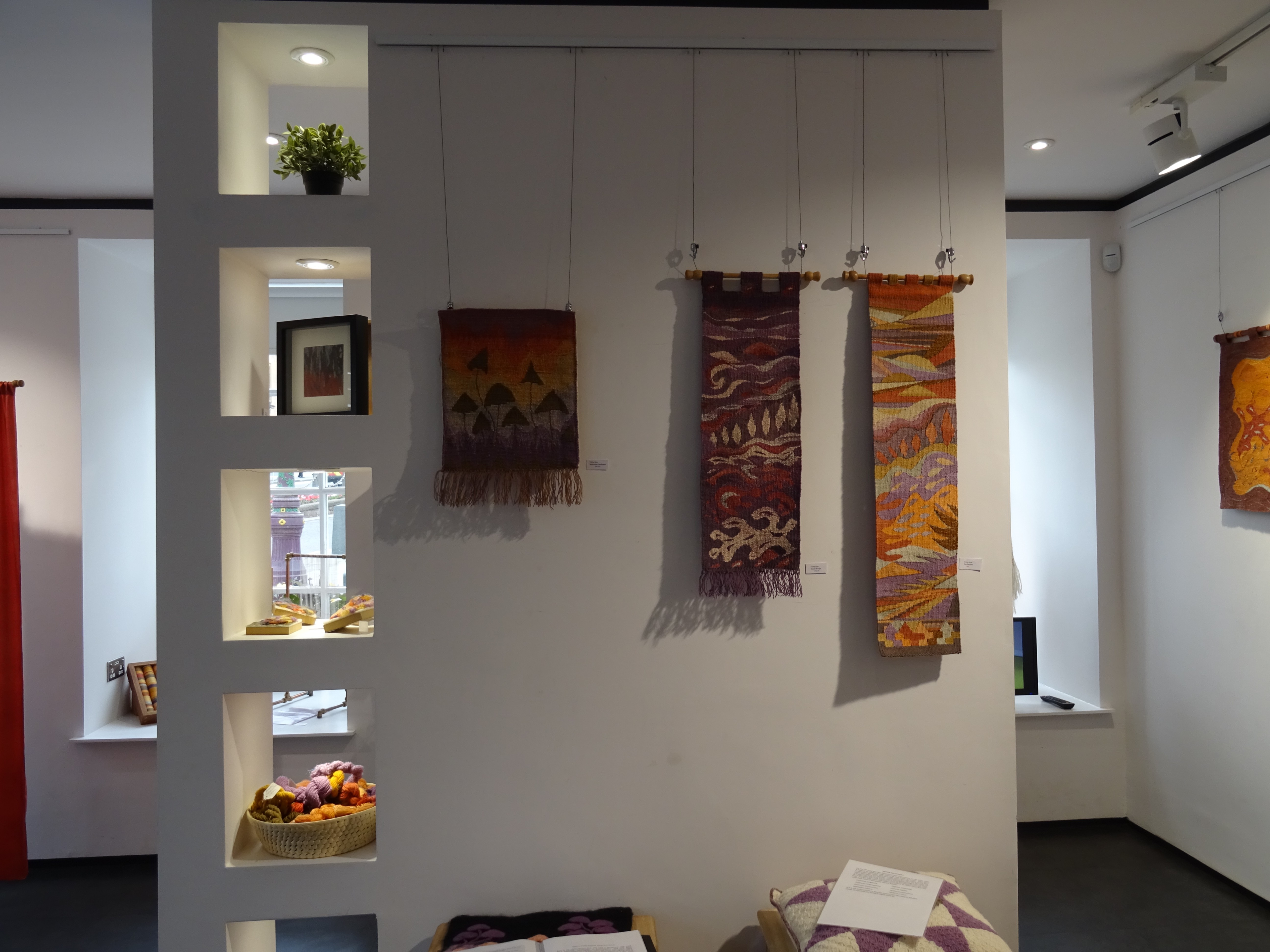 |
We had
lots of lovely comments in the visitors’ book at the exhibition.
All The
folk who came to see the exhibition were totally amazed by
the beauty and wide range of the colours that certain species
of fungi can yield – from the subtle greens and yellows to
the vivid reds and purples. When I give talks to groups I
always get the same reaction, especially when they see Hapalopilus
nidulans –
how can a small brown bracket fungi give such a vivid purple
colour? Do we know how it was discovered that it would react
with ammonia to give purple? Was a piece on the ground, an
animal urinated on it and someone noticed the reaction? Or
was a mushroom expert testing different fungi with acidic
and alkaline solutions? Cortinarious semisanguineus is
fantastic, too. Two colours in one small mushroom, red in
the cap and orange in the stem. So many potential colours.
As our exhibition title says - Fabulous FungiDyes indeed!
We are really looking forward to seeing you all next year in Port Townsend.
Marilyn Caddell |
|
The IMDI (International Mushroom
Dye Institute)
The IMDI mounted
an exhibition at the Ford House in Mendocino, CA, celebrating the
landmark research of Miriam C. Rice in fungal fiber arts! |
| |
|
| |
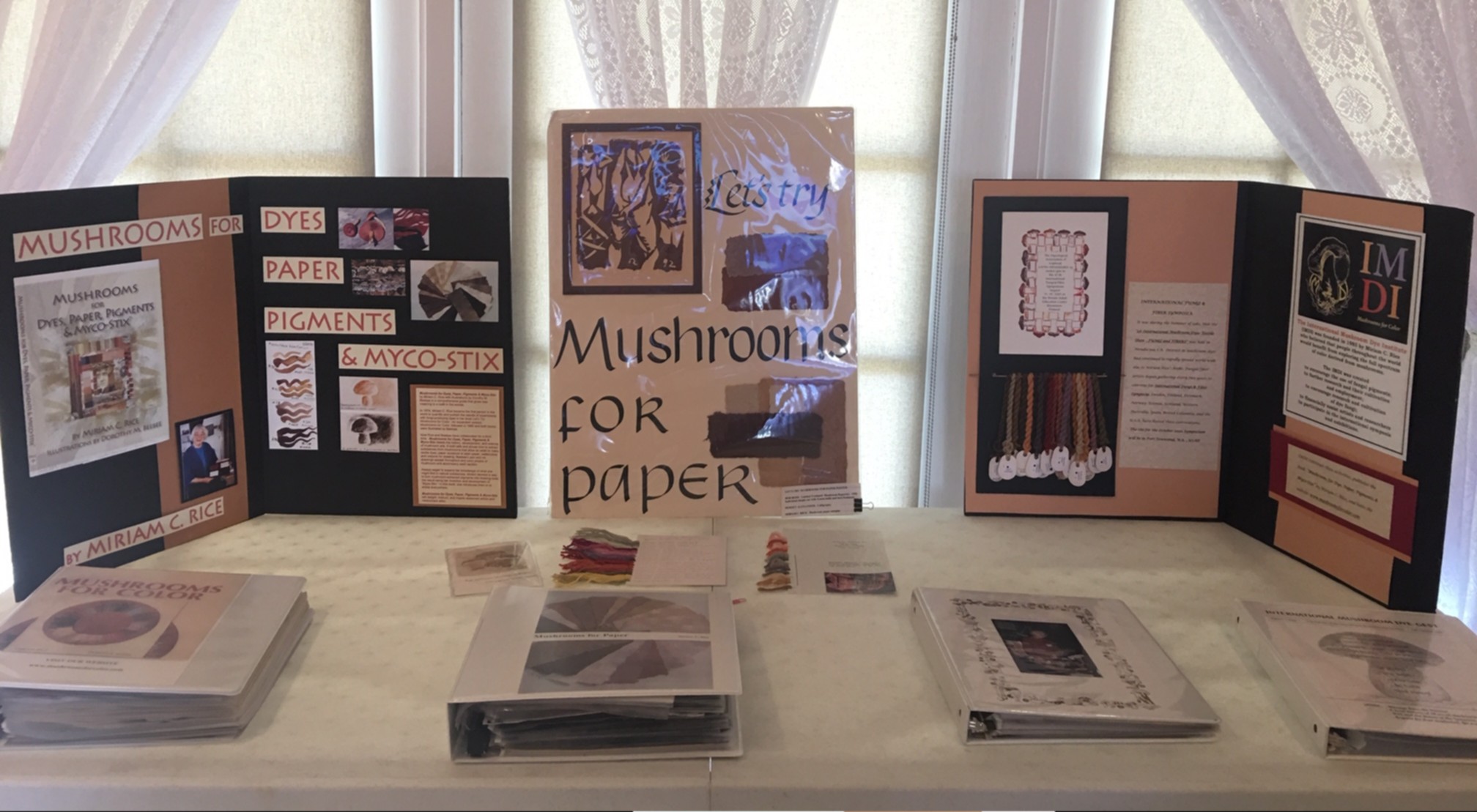
| IMDI
menbers Nancy Denison and Dorothy Beebee at mushroom dye
display in Ford House (Photos by Jill Surdzial) |
|
|
|
2017 International
Fungi and Fibre Newsletter
News of the Danish dyeing group by Jytte Albertsen,
Denmark
In December 2016
and January 2017 some
in the group were experimenting with varying the concentration of mordants.
We tried 4 different mordants : alum, tin, iron and copper. We did all
the mordanting at room temperature for 24hours, and at 85C for 45 minutes.
Starting with 10% and then going down to 0.5% ( except tin that started
at 2% and came down to 0.5% ). The dyeing was done with Phaeolus schweinitzii in
separate glass jars for each of the 10g yarn. The dyeing was done at 85C. I can
send more details from the experiments if someone is interested, and I will bring
the dyed yarn to Norway. It it difficult to explain the difference in colours
in writing, better to see it and have it in your hands!
|
In
April 2017 we had a workshop on the mushroom
dyeing of cotton. Sagarika Devi
from India was the instructor of the workshop and we learned a lot. There were
16
people in the workshop and we dyed different kinds of cotton with 2 different
mushrooms : Cortinarius semisanguineus and Phaeolus
schweinitzii. Thank you
Sagarika, it was great to have you living in Denmark, and have you take part
in the
Danish activities. |
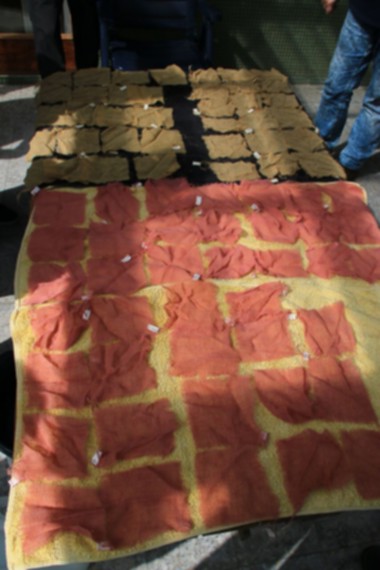 |
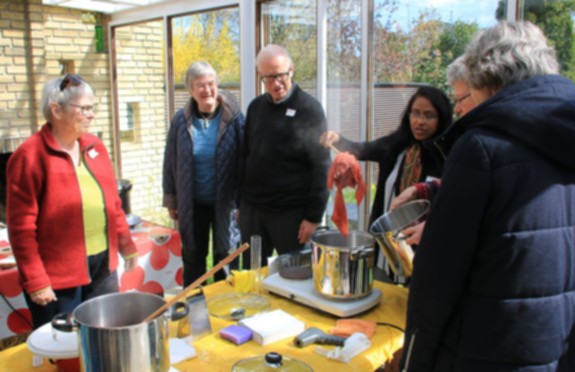 |
In
May 2017 we had a workshop in papermaking of polypores. Liza
Johannson came down from Sweden, and we had some great days with
her in Denmark. We had been collecting polypores all winter and dryed
them so we had a lot. We gathered in Hornbæk in North Sealand and
about 25 people participated. At the end of the day we all had some
very nice paper
in different colours to take home. Thank you Liza. It was a great
day.
In September 2017 the mushroom society had an exhibition
in Rådvad, and the dyeing group demonstrated dyeing and papermaking
and showed some of our mushroom dyed creations.
I hope to see all of you in Norway in August 2018!
|
Memories of Janette McKeown , by Marilyn Caddell, Scotland
Sadly we have only recently learned that Janette
died a few months ago. Many of you will remember her and her daughter,
Eleanor, in a wheelchair. Janette was widowed many years ago and as
she put her son through agricultural college she asked Eleanor what
she would like to do. “Go round the world in 80 days” Eleanor replied.
Well, it took rather more than that, but the two of them travelled
extensively to many countries, including most of the fungi symposia
venues since the Scottish one in 1993.
|
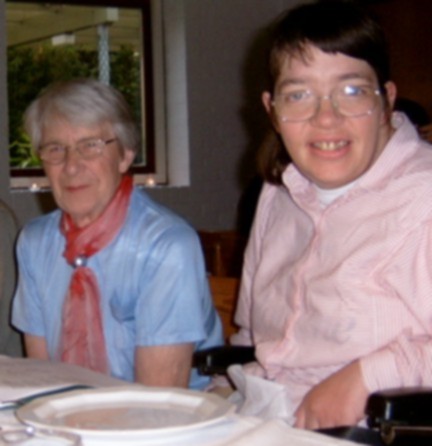 |
Janette & Eleanor |
| |
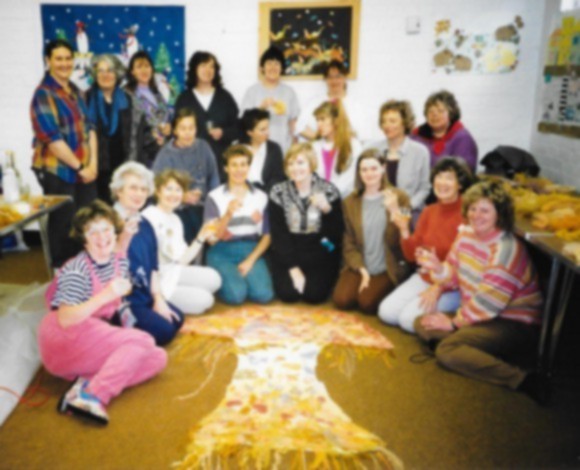 |
Janette is second from the
left in the front row of the photo
|
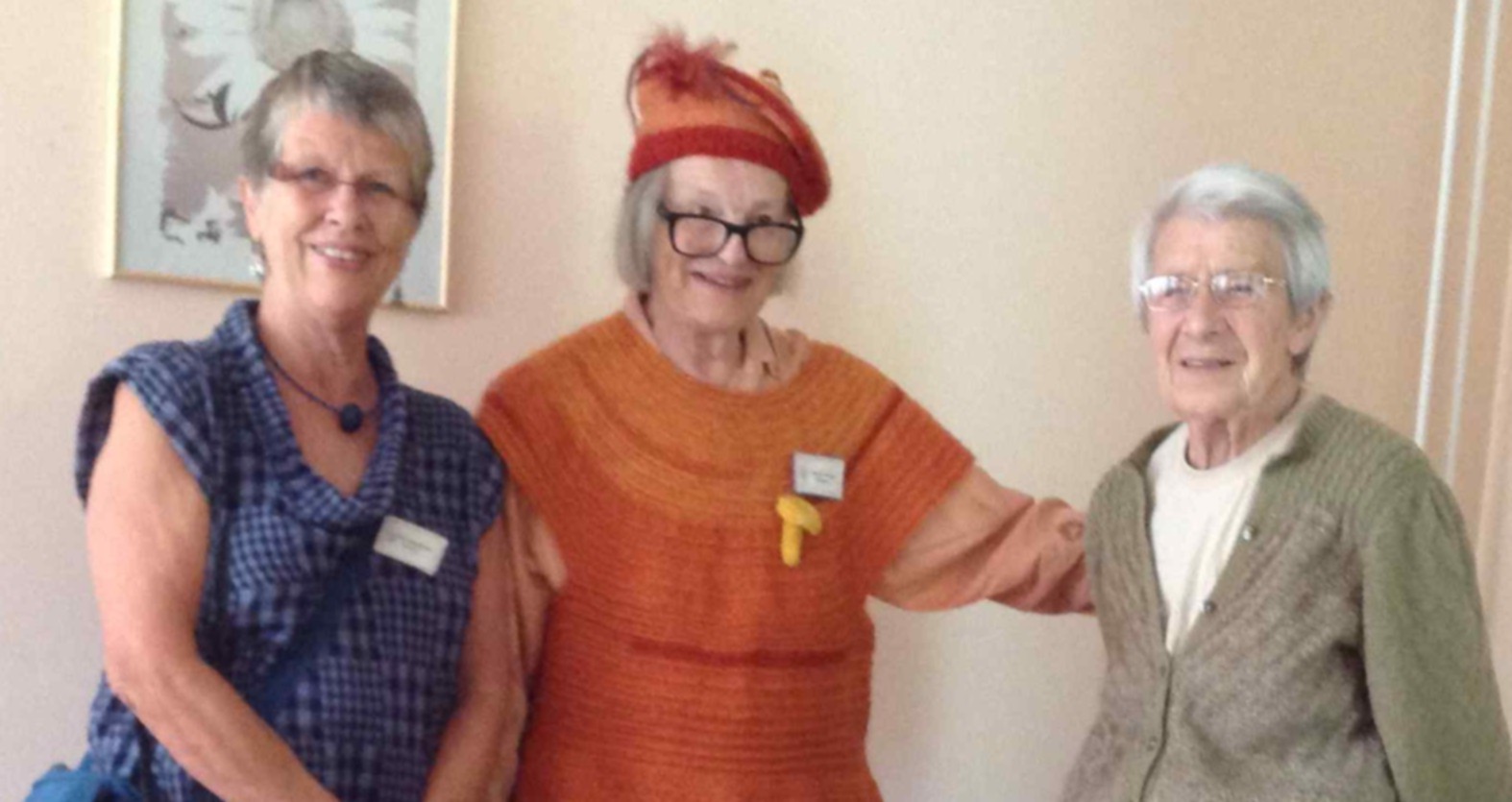 |
Janette (far right)
was a very talented needlewoman, spinner, weaver, felter and also a
judge of floral art. My favourite memory of Janette is of an afternoon
spent with Janette and two other ladies also in their 80’s. Just listening
to them talking was magic! Janette was wonderful friend and I will miss
her. |
Trisha
Gow in Scotland presented the IFFF
NEWSLETTER 2016 with individual
contributions from many countries represented in the IFFF.
(Articles
from Newsletter # 1 are also available on their country's individual
pages. All materials
are covered by International Copyright by the contributors.)
Mushrooms for
Color Website designed by Dorothy Beebee © 2019
All rights reserved. (This Website page was updated December 07, 2019)
